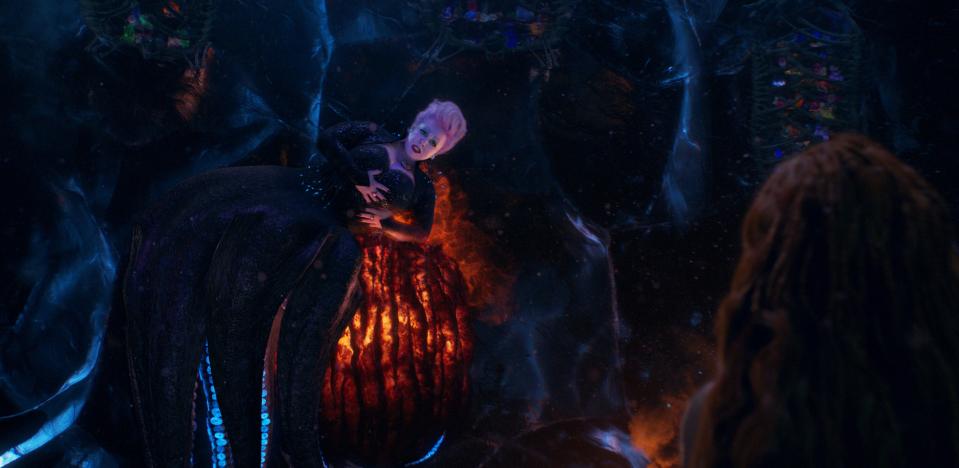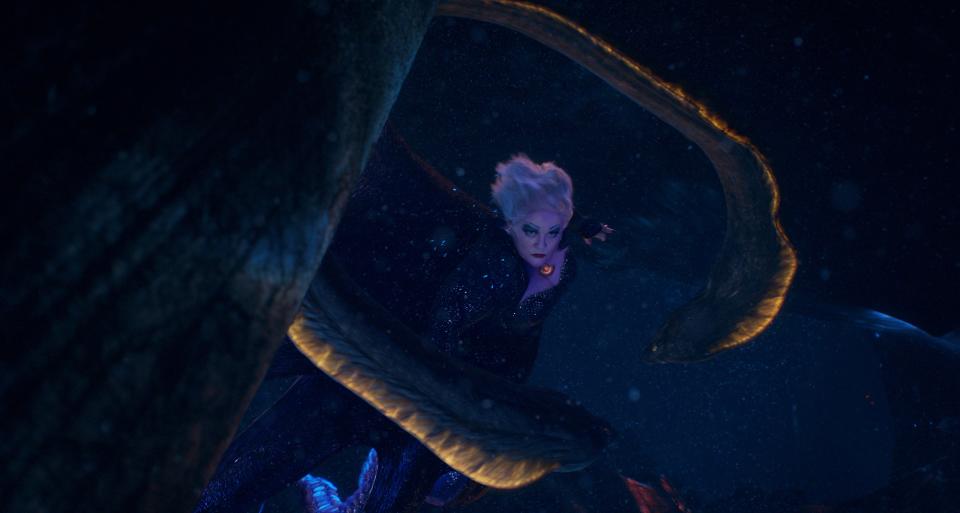Designing a Showstopping and Terrifying Ursula for ‘The Little Mermaid’

- Oops!Something went wrong.Please try again later.
Always the musical showman, “The Little Mermaid” director Rob Marshall insisted that the most gestural parts of Melissa McCarthy’s live-action performance as Ursula were supported by eight puppeteered tentacles. This was especially vital during the Divine-inspired “Poor Unfortunate Souls” showstopper, where the sea witch lures Ariel (Halle Bailey) into a trap to become human.
“For Rob, performance is the most important thing,” MPC VFX supervisor Patrick Ledda told IndieWire. “And, in particular, the musical beats. For instance, ‘Poor Unfortunate Souls’ was built in layers. The first version that Rob shot, he was literally using a Disney Ursula doll, and the set was just made of simple cardboard boxes, and he would move the doll around to create the journey of Ursula in this world. Then we did a previs pass to visualize the whole sequence very roughly.”
More from IndieWire
This progressed to the eventual “dry for wet” shoot to simulate being underwater on a blue screen stage at Pinewood Studios in England. There, McCarthy was attached by a harness to a Tuning Fork rig on wheels, controlled and moved around by a couple of guys in blue suits. “It was all choreographed, and she was free to move her upper body and emote,” Ledda said. “Rob would then add that puppeteer performance of the tentacles, and they would match Melissa’s performance. Then once we got the plates with the puppeteers, we obviously replaced a lot of it and it became a digital performance.”

Then came the time-consuming part: animating eight independently moving tentacles. First, they looked at lots of octopus references and added plenty of controls so that the MPC animators could manipulate the performance. “And then there would be some software that would automatically add secondary dynamics,” added Ledda. “So you end up with all these little curls and twirls like when you look at a real octopus.”
“We had to figure out where to blend but, in the end, most of her body is digital,” he added. “We kept her hands and her face. That allowed us to take over just under the chest so we could have the stomach region and then blend that into the tentacles.”
McCarthy’s hair was CG as well, which was hard because it needed to behave as if underwater, which can get messy and ugly. That required advanced techniques to manipulate artistically to Marshall’s liking. “Rob was quite picky,” Ledda said. “It was started as a simulation, but then we modified certain poses. We also wrote some tools where we could start in one direction and make sure the hair wants to go in that direction without being forced. We had a first pass on ‘Poor Unfortunate Souls,” which I love, but Rob felt that the hair was too loose. Then we did a whole other pass and it was too stiff, and eventually we landed where we wanted to.”

The biggest decision was what to do about the underwater look of skin. Marshall wanted the look of the film overall to resemble “Blue Planet,” but he drew the line when it came to the facial performances of his actors, and opted instead for more appealing skin and eyes. “He wanted this more like the live-action portion where the actors were shot in a traditional way on a set,” Ledda said. “He didn’t want to modify the photography.”
Meanwhile, for the climactic battle with “Big Ursula” attacking the kingdom and the ocean turning into a giant whirlpool, MPC upped its animation. The studio rewrote its water simulation to have greater latitude and artistic control to set the right properties.
“Very early on, in very rough versions, Rob gave notes on the heights of the waves and the wind and all the other properties,” added Ledda. “And that was useful because we knew that we couldn’t wait until a proper final simulation for his notes. It took a long, long time. Rob had essentially no notes. On that sequence, once he saw close to the final image, he was very complimentary.”

The animation of the character had its own challenges because the first version they did was essentially Ursula, only 47 times bigger. First, they did a facial capture session of McCarthy with some markers, directed by Marshall, to deliver the performance that would be translated into a giant zombie version of Ursula.
“And that was the original idea, but it was difficult on that scale because it still looked like the same character. So it was a bit odd and some of the comments we got was that she wasn’t scary enough. It was going to be at night with complex water and the lightning, so we went through many rounds of concept work with our art department and Rob, and we landed on a version, to be honest, about three or four months before the delivery of the film.”
But then there were concerns that Ursula was too scary for young kids after applying more octopus skin all over her face and neck, changing her pupil design, and making her hair more scraggly and dirty. So they played with how much to see of her. “Rob always had this idea that we never see her very well,” Ledda said. “It’s like you see flashes of her, but it’s not quite clear what you’re looking at. And that was the mysterious language that we landed on.”
Best of IndieWire
Sign up for Indiewire's Newsletter. For the latest news, follow us on Facebook, Twitter, and Instagram.

